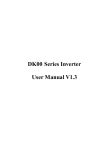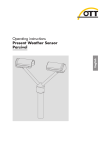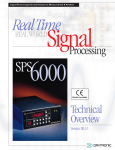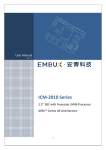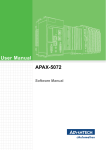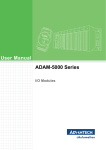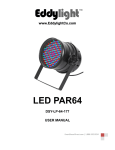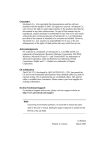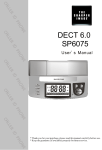Download Adam Equipment RS-485 User`s manual
Transcript
Ethernet to Modbus Data Gateway User’s Manual Preface and Table of Contents ADAM-4572 User's Manual Copyright Notice This document is copyrighted, 2000, by Advantech Co., Ltd. All rights are reserved. Advantech Co., Ltd., reserves the right to make improvements to the products described in this manual at any time without notice. No part of this manual may be reproduced, copied, translated or transmitted in any form or by any means without the prior written permission of Advantech Co., Ltd. Information provided in this manual is intended to be accurate and reliable. However, Advantech Co., Ltd. assumes no responsibility for its use, nor for any infringements upon the rights of third parties which may result from its use. Acknowledgments ADAM is a trademark of Advantech Co., Ltd. IBM and PC are trademarks of International Business Machines Corporation. CE Notification The ADAM-4572 developed by Advantech Co., Ltd. has passed the CE test for environmental specifications. Test conditions for passing included the equipment being operated within an industrial enclosure, using shielded twisted-pair RS-485 cables. In order to protect the ADAM-4572 system from being damaged by ESD (Electrostatic Discharge) and EMI leakage, we strongly recommend the use of CEcompliant industrial enclosure products and shielded twisted-pair RS485 cables. Part No. 2000457200 Printed in Taiwan 1st Edition August 2000 Preface and Table of Contents A Message to the Customer... Advantech Customer Services Each and every Advantech product is built to the most exacting specifications to ensure reliable performance in the unusual and demanding conditions typical of industrial environments. Whether your new Advantech equipment is destined for the laboratory or the factory floor, you can be assured that your product will provide the reliability and ease of operation for which the name Advantech has come to be known. Your satisfaction is our number one concern. Here is a guide to Advantech’s customer services. To ensure you get the full benefit of our services, please follow the instructions below carefully. Technical Support We want you to get the maximum performance from your products. So if you run into technical difficulties, we are here to help. For most frequently asked questions you can easily find answers in your product documentation. These answers are normally a lot more detailed than the ones we can give over the phone. Please consult this manual first. If you still cannot find the answer, gather all the information or questions that apply to your problem and, with the product close at hand, call your dealer. Our dealers are well trained and ready to give you the support you need to get the most from your Advantech products. In fact, most problems reported are minor and are able to be easily solved over the phone. In addition, free technical support is available from Advantech engineers every business day. We are always ready to give advice on application requirements or specific information on the installation and operation of any of our products. ADAM-4572 User's Manual Product Warranty Advantech warrants to you, the original purchaser, that each of its products will be free from defects in materials and workmanship for two years from the date of purchase. This warranty does not apply to any products which have been repaired or altered by other than repair personnel authorized by Advantech, or which have been subject to misuse, abuse, accident or improper installation. Advantech assumes no liability as a consequence of such events under the terms of this Warranty. Because of Advantech’s high quality-control standards and rigorous testing, most of our customers never need to use our repair service. If an Advantech product ever does prove defective, it will be repaired or replaced at no charge during the warranty period. For out-of-warranty repairs, you will be billed according to the cost of replacement materials, service time and freight. Please consult your dealer for more details. If you think you have a defective product, follow these steps: 1. Collect all the information about the problem encountered (e.g. type of PC, CPU speed, Advantech products used, other hardware and software used etc.). Note anything abnormal and list any on-screen messages you get when the problem occurs. 2. Call your dealer and describe the problem. Please have your manual, product, and any helpful information readily available. 3. If your product is diagnosed as defective, you have to request an RMA number. When requesting an RMA (Return Material Authorization) number, please access ADVANTECH’s RMA website: http:// www.advantech.com.tw/rma. If the web sever is shut down, please contact our office directly. You should fill in the “Problem Repair Form”,describing in detail the application environment, configuration, and problems encountered. Note that error descriptions such as “does not work” and “failure” are so general that we are then required to apply our internal standard repair process. 4. Carefully pack the defective product, a completely filled-out Repair and Replacement Order Card and a photocopy of dated proof of purchase (such as your sales receipt) in a shippable container. A Preface and Table of Contents product returned without dated proof of purchase is not eligible for warranty service. 5. Write the RMA number visibly on the outside of the package and ship it prepaid to your dealer. ADAM-4572 User's Manual Contents 1. Introduction ......................................................................... 1 1.1 ADAM Data Gateway Series .............................................................. 2 1.2 Protocol .............................................................................................. 2 1.2.1 1.2.2 1.2.3 1.2.4 Overview ............................................................................................ 3 Modbus/RTU ..................................................................................... 4 Modbus/ASCII .................................................................................. 5 Modbus/TCP ..................................................................................... 6 2. Installation Guidelines ....................................................... 7 2.1 System Requirement ......................................................................... 8 2.1.1 2.1.2 Host computer ................................................................................... 8 ADAM-4572 Ethernet to Modbus Data Gateway ........................... 8 2.2 Communication Wiring .................................................................... 9 2.2.1 2.2.2 2.2.3 Serial Port Wiring ............................................................................... 9 Third Party Modbus Serial Device Wiring ...................................... 11 Ethernet Port Wiring ........................................................................ 12 2.3 Power Supply ................................................................................... 13 2.4 LED Indicator ................................................................................... 14 2.5 Network Cabling .............................................................................. 15 3. Utility Software .................................................................. 17 3.1 Installation of Utility Software ......................................................... 18 3.2 Configuration .................................................................................. 20 3.2.1 3.2.2 3.2.3 3.2.4 3.2.5 System Configuration ...................................................................... 20 Network Configuration .................................................................... 22 Serial Port Configuration .................................................................. 23 Modbus Configuration ..................................................................... 25 Status Messages ............................................................................... 26 4. Features and Specifications ............................................ 29 4.1 Features ........................................................................................... 30 4.2 Hardware Specifications .................................................................. 32 Preface and Table of Contents Appendix A Configuration Example .................................... 35 A.1 OPC Server ..................................................................................... 36 A.2 FIX ................................................................................................... 37 Appendix B Application ........................................................ 41 Appendix C Technical Diagrams ......................................C-45 C.1 ADAM Dimensions ...................................................................... C-46 C.2 Installation ................................................................................... C-47 C.2.1 DIN-Rail Mounting ..................................................................... C-47 C.2.2 Panel Mounting ............................................................................ C-49 C.2.3 Piggyback Stack ........................................................................... C-51 Appendix D RS-485 Network ............................................... 53 D.1 Basic Network Layout ..................................................................... 55 D.2 Line Termination ............................................................................. 59 D.3 RS-485 Data Flow Control ............................................................... 61 ADAM-4572 User's Manual Tables Table 1-1: Comparison of Modbus RTU and ASCII mode .......................... 5 Table 2-1: Functional Status of LED .......................................................... 14 Table 3-1: Table 3-2: Settings of Modbus/ASCII ........................................................ 24 Settings of Modbus/RTU .......................................................... 24 Preface and Table of Contents Figures Figure 1-1: Modbus System Architecture ................................................... 4 Figure 2-1: The ADAM-4572 Module Front View .......................................... 8 Figure 2-2: Pin assignment of 3P to DB 9 cable .......................................... 9 Figure 2-3: Wiring of RS-232 Connection .................................................. 10 Figure 2-4: Wiring of RS-485 Connection .................................................. 10 Figure 2-5: Wiring of RS-422 Connection .................................................. 10 Figure 2-6: Connecting to Modbus Serial Devices (RS-232) .................... 11 Figure 2-7: Connecting to Modbus Serial Devices (RS-485) .................... 11 Figure 2-8: Connecting to Modbus Serial Devices (RS-422) .................... 12 Figure 2-9: ADAM-4572 Ethernet Interface ............................................... 12 Figure 2-10: Connecting the Hub and ADAM-4572 ...................................... 13 Figure 2-11: RJ-45 Pin Assignment (Ethernet) ........................................... 13 Figure 2-12: Position of LED Indicators ....................................................... 14 Figure 2-13: Network Cabling (Central way) ............................................... 15 Figure 2-14: Network Cabling (Distributed Architecture) ........................... 15 Figure 3-1: Figure 3-2: Figure 3-3: Figure 3-4: Figure 3-5: Figure 3-6: Figure 3-7: Figure 3-8: Figure 3-9: Installing Configuration Utility ................................................. 18 Choosing the Destination Directory ........................................ 19 Installation Complete ............................................................... 19 Configuration Utility .................................................................. 20 System Setting Window .......................................................... 21 Network Setting Window ......................................................... 22 Port Setting Window ................................................................ 23 Modbus Configuration Window ............................................... 25 Status Bar ................................................................................. 26 Figure 4-1: ADAM-4572 Module Dimension ............................................... 33 Figure A-1: Figure A-2: Figure A-3: Figure A-4: Figure A-5: Figure A-6: Figure A-7: Device Property Setting ........................................................... 36 Searching File ........................................................................... 37 Select Notepad Program ......................................................... 37 Add IP Address of ADAM-4572 to FIX ..................................... 38 Select System Configuration of FIX ........................................ 39 Select MBE Item ....................................................................... 39 Add the IP address of ADAM-4572 into MBE .......................... 40 Figure B-1: Application example of ADAM-4572 ....................................... 42 ADAM-4572 User's Manual Figure C-1: Figure C-2: Figure C-3: Figure C-4: Figure C-5: Figure C-6: ADAM Modules Dimensions ................................................ C-46 DIN-Rail Adapter ................................................................... C-47 DIN-Rail Mounting ................................................................. C-48 Panel Mounting Bracket Dimensions ................................. C-49 Panel Mounting ..................................................................... C-50 Piggyback Stack .................................................................. C-51 Figure D-1: Figure D-2: Figure D-3: Figure D-4: Figure D-5: Figure D-6: Figure D-7: Daisychaining ........................................................................... 55 Star structure ........................................................................... 56 Random structure .................................................................... 57 ADAM-4000 and ADAM-5000 in a network ............................. 58 Signal distortion ....................................................................... 59 Termination resistor locations ................................................ 60 RS-485 data flow control with RTS ......................................... 61 Preface and Table of Contents ADAM-4572 User's Manual CHAPTER 1 Introduction 1.1 ADAM Data Gateway Series Networks have become increasingly vital for industrial automation applications. Many control devices today do not have a network port and can only communicate with a dedicated local PC or control panel. Advantech’s revolutionary network-enabling technology is now allowing control devices with serial ports to connect to the Ethernet and share networks quickly and cost-effectively. The ADAM-4572 Ethernet to Modbus Data Gateway is a new product of ADAM Data Gateway series from Advantech that allows users to integrate new and existing Modbus/RTU and Modbus/ASCII serial devices to newer TCP/IP network-based devices. Manufacturers, system integrators, and end users can now take advantage of the ADAM-4572 to create networked applications for remote managing and to accessing data for their control devices that wasn't possible before. 1.2 Protocol Originally developed for PLCs in industrial automation and manufacturing control applications, Modbus has become one of the most popular open standard protocols in use today. When it comes to planning data communication for open, multi-vendor industrial control systems, Modbus is the first choice of end users and integrators. Although it’s not the most powerful protocol available, its rare simplicity allows not only rapid implementation, but also remains flexible enough to be applied in virtually all industrial situations. The communication mode of Modbus can be ASCII, RTU, or TCP/IP. The ADAM-4572 is used to support applications such as protocol conversion between serial (Modbus/ASCII or Modbus/RTU) and networked (Modbus/TCP) Modbus devices or it can be used to bridge Modbus serial devices over TCP/IP network. 2 ADAM-4572 User's Manual 1.2.1 Overview The Modbus/RTU and Modbus/ASCII protocols define how a “master” device polls one or more “slave” devices to read and write real-time data over RS-232, RS-422, or RS-485 serial data communication. The simplicity of Modbus/RTU not only allows rapid implementation, but can also remain flexible enough to be applied in virtually all industrial situations. During Modbus network communication, the protocol determines how each controller will know its device address, recognize a message addressed to it, determine the kind of action to be taken, and extract any data or other information contained in the message. If a reply is required, the controller will construct the reply message and send it back using Modbus protocol. The way controllers communicate with each other is by using a masterslave technique, in which only one device (the master) can initiate queries. The other devices (the slaves) respond by supplying the requested data to the master, or by taking the action requested in the query. Typical master devices include host processors and programming panels. Typical slaves include programmable controllers. It is the master that can address individual slaves and initiate a broadcast message to all slaves. On the other hand, slaves return a response to queries that are addressed to them individually. Responses are not returned to broadcast queries from the master. The Modbus protocol has a definite format for the master’s query, which incorporates the device (or broadcast) address, a function code defining the requested action, any data to be sent, and an error-checking field. The slave’s response message, which is also constructed using Modbus protocol, contains fields confirming the action taken, any data to be returned, and an error-checking field. If an error occurred in receipt of the message, or if the slave is unable to perform the requested action, the slave will construct an error message and send it as its response. The basic system architecture is as follows: Chapter 1 Introduction 3 PC PC PC Ethernet Modbus/TCP Ethernet ADAM Ethernet ADAM-4572 RS-232/485/422 ADAM ADAM-4572 RS-232/485/422 Modbus/RTU Modbus/ASCII ADAM-5511 PLC ADAM-5000/MOD 3rd party device (RTU) Figure 1-1: Modbus System Architecture 1.2.2 Modbus/RTU The Modbus/RTU protocol defines how a “master” device polls one or more “slave” devices to read and write data in real-time over RS-232, RS-422, or RS-485 serial data communication. When using RTU mode, each 8-bit byte in a message contains two 4-bit hexadecimal characters. The main advantage of this mode is that its greater character density allows better data throughput than ASCII mode for the same baud rate. Nevertheless, each message must be transmitted in continuous stream. 4 ADAM-4572 User's Manual 1.2.3 Modbus/ASCII When using ASCII mode, each 8-bit byte in a message is sent as two ACSII characters. The primary advantage of this ASCII mode is that it allows time intervals of up to one second to occur between characters without causing an error. Mode RTU ASCII Coding System 8-bit binary. Two hexadecimal character contained in each ASCII character of the message Hexadecimal. One hexadecimal character contained in each ASCII character of the message Bits per Byte 1 start bit, 8 data bits, 1 bit for even/odd parity; no bit for parity 1 stop bit if parity is used; 2 bits if no parity 1 start bit , 7 data bits, 1 bit for even/odd parity; no bit for parity 1 stop bit if parity is used; 2 bits if no parity Error check CRC LRC Table 1-1 Comparison of Modbus RTU and ASCII mode Chapter 1 Introduction 5 1.2.4 Modbus/TCP As a new extension of Modbus/RTU, the Modbus/TCP protocol defines how Modbus/RTU messages are encoded within and transported over TCP/IP-based networks. Modbus/TCP is just as simple to implement and flexible to apply as the original Modbus/RTU. The Modbus/TCP protocol is defined by its form of encapsulation for a Modbus request or response. That means the Modbus request or response data is encapsulated in TCP frame that has a six-byte header in Modbus/TCP protocol. Modbus/TCP enables the use of Modbus messaging in an Intranet running the TCP/IP protocols. Modbus/TCP is most commonly used for Ethernet attachment of PLC’s or I/O modules to other simple field buses or I/O networks. 6 ADAM-4572 User's Manual CHAPTER 2 Installation Guidelines 2.1 System Requirement 2.1.1 Host computer 1. IBM PC compatible computer with Ethernet network interface card (Pentium CPU is strongly recommended). 2. Microsoft Windows NT 4.0 (with Service Pack 3 or above). 3. HMI software with Modbus/TCP protocol or OPC Modbus/TCP Server (e.g. Advantech GeniDAQ 4.0; In Touch 7.0; FIX 7.0, ICONICS 5.0 or above) installed. 2.1.2 ADAM-4572 Ethernet to Modbus Data Gateway 1. One ADAM-4572 user’s manual. 2. One ADAM-4572 configuration utility diskette. 3. One ADAM-4572 module 4. One rack-mount kit 5. One 3P to DB 9 cable (Ethernet) Status/Power Speed/Link TX/RX (Ethernet) TX/RX (Serial) GND (R)+Vs TX (RS-232) RX RX- (RS-422) RX+ TX(DATA-) TX+ 1 (DATA+) (RS-485) (B)GND 10 Ethernet to Modbus Data Gateway Figure 2-1: The ADAM-4572 Module Front View 8 ADAM-4572 User's Manual • 1 SHIELD WHITE • 2 Rx RED • 3 Tx • 4 DTR BLACK • 5 GROUND • 6 DSR • 7 RTS • 8 CTS • 9 NC TX: Transmitted Data DTR: Data Terminal Ready RX: Received Data CTS: clear to Send RTS: Request to Send N/C:No Connection DSR: Data Set Ready CD: Carrier Detect Figure 2-2: Pin assignment of 3P to DB 9 cable 2.2 Communication Wiring 2.2.1 Serial Port Wiring We recommend that shielded-twisted-pair cables that comply with the EIA RS-485 standard be used with the ADAM network to reduce interference. Only one set of twisted-pair cables is required to transmit both Data and RTS signals. We advise that the following standard colors (as indicated on the modules) be used for the communication lines: DATA + (Y) -> Yellow DATA - (G) -> Green Chapter 2 Installation Guidelines 9 Wiring for RS-232 Connection TX+ (DATA+) TX(DATA-) RX+ RXRX TX GND + 10 ~ 30 VDC - +Vs GND Figure 2-3: Wiring of RS-232 Connection Wiring of RS-485 Connection Figure 2-4: Wiring of RS-485 Connection Wiring of RS-422 Connection Figure 2-5: Wiring of RS-422 Connection 10 ADAM-4572 User's Manual 2.2.2 Third Party Modbus Serial Device Wiring Wiring of RS-232 connection When connecting RS-232 interface of ADAM-4572 to a third party device with DB-9 interface for data transmission, please follow the illustration below to short pin 4 and pin 6, pin 7 and pin 8 respectively at the DB9 end. Figure 2-6: Connecting to Modbus Serial Devices (RS-232) Wiring of RS-485 and RS-422 connection If you are using RS-485 or RS-422 interface for data transmission, follow standard connection. ADAM-4572 Modbus Serial Device TX+ • Data + TX- • Data - (DATA+) (DATA-) RX+ RXRX TX GND +Vs GND TX: Transmitted Data RX: Received Data Figure 2-7: Connecting to Modbus Serial Devices (RS-485) Chapter 2 Installation Guidelines 11 ADAM-4572 TX+ (DATA+) TX(DATA-) Modbus Serial Device • Rx + • Rx - RX+ • Tx + RX- • Tx - RX TX GND +Vs GND TX: Transmitted Data RX: Received Data Figure 2-8: Connecting to Modbus Serial Devices (RS-422) 2.2.3 Ethernet Port Wiring The ADAM-4572 uses a RJ-45 connector to interface with the Ethernet, and supports 10/100 Mbps transmission speed. The ADAM-4572 configuration utility will auto-detect the current transmission speed on the network and configure itself accordingly. Furthermore, we provide 1500 Vrms isolation for the Ethernet end to protect the ADAM-4572 from damages caused by over-voltage. Figure 2-9: ADAM-4572 Ethernet Interface Grounding The ADAM-4572 Ethernet interface, as required by the Ethernet standard, must be grounded. 12 ADAM-4572 User's Manual Cabling requirements for the Ethernet side Use the RJ-45 connector to connect the Ethernet port of the ADAM4572 to the Hub. The cable for connection should be Category 3 (for 10Mbps data rate) or Category 5 (for 100 Mbps data rate) UTP/STP cable, which is compliant with EIA/TIA 586 specifications. Maximum length between the Hub and any ADAM-4572 is up to 100 meters (ca. 300 ft). RJ-45 1 Tx + 2 Tx 3 Rx + 4 NC 5 NC 6 Rx - 7 NC 8 NC NC: No Connection Figure 2-10: Connecting the Hub and ADAM-4572 Figure 2-11: RJ-45 Pin Assignment (Ethernet) 2.3 Power Supply The ADAM-4572 is supplied with +10~+30 VDC power via twisted-pair wire. Power consumption can also vary with connected transceivers, phantom current, etc. Furthermore, a 34V surge protection is added to the power end. Chapter 2 Installation Guidelines 13 2.4 LED Indicator The ADAM-4572 has 4 LED indicators for users to monitor its functional status. Figure 2-12: Position of LED Indicators ☛ Note: LED indicators will be red or green, not both LED Color Red Status/Power Green Red Speed/Link Green Red Tx/Rx (Ethernet) Green Red Tx/Rx (Serial) Green Status Description ON Heartbeat (1 time/sec) OFF Not working ON Power ON OFF Power OFF ON 100 Mbps speed OFF 10 Mbps speed ON Valid network link OFF Invalid network link ON Data being transmitted OFF No data being transmitted ON Data being received OFF No data being received ON Data being transmitted OFF No data being transmitted ON Data being received OFF No data being received Table 2-1 Functional Status of LED 14 ADAM-4572 User's Manual 2.5 Network Cabling The following illustration is a quick reference of network cabling for you to set up network in your factory. Figure 2-13: Network Cabling (Central way) Figure 2-14: Network Cabling (Distributed Architecture) Chapter 2 Installation Guidelines 15 16 ADAM-4572 User's Manual CHAPTER 3 Utility Software 3.1 Installation of Utility Software Before you use the ADAM-4572, you have to install the ADAM-4572 configuration utility. Please follow the steps as described below: 1. Insert the ADAM-4572 configuration utility diskette into the floppy drive (e.g. a:\) on the host PC. Change the host computer’s default drive from C: to A: 2. Use your Windows Explorer or the Windows Run command to execute the Setup Program. (The path for the Setup program on diskette should be A:\setup.exe, if your default floppy drive is A:). Figure 3-1: Installing Configuration Utility 3. The Setup program will specify for you a default installation path, C:\Program Files\Advantech\ADAM4572. If you are not satisfied with the default installation path, just click the Browse button to change to another path. After you have specified the installation path, click the Next button. The program will start to copy the program files to your computer. 18 ADAM-4572 User's Manual Figure 3-2: Choosing the Destination Directory Figure 3-3: Installation Complete 4. After Setup has copied all program files to your computer, click the Finish button to finish the installation. Configuration utility will then search the ADAM-4572 device on your local area network automatically. Chapter 3 Utility Software 19 Figure 3-4: Configuration Utility 3.2 Configuration The ADAM-4572 provides easy configuration by Windows utility through Ethernet connection. This Windows utility searches all the ADAM-4572 devices on the network automatically and you can configure various parameters for TCP/IP configuration easily. For secure administration, it can also restrict the access right for configuration to only one host PC to enhance network security. With this secure function enabled, other PCs will not have access right for configuration. The Windows utility consists of four functional categories: System, Network, Port and Modbus, which are presented on the toolbar of the configuration utility. 3.2.1 System Configuration Configuration utility can only search the ADAM-4572 devices on the local network segment and cannot search beyond a router or gateway. Therefore, before you set up the network, you have to make sure that all the ADAM-4572 devices that you want to monitor must reside on the same local network segment with the host PC. 20 ADAM-4572 User's Manual Figure 3-5: System Setting Window ADAM Data Gateway In this column, you will see all the found ADAM-4572 devices are listed when you use the configuration utility to auto-search ADAM-4572 devices. The specific number following each ADAM-4572 device is its Ethernet Address. The Ethernet Address is what helps the local system to identify and locate each ADAM device. This Ethernet Address is already set before delivery from factory, hence no need for further configuration. Device Name Configuration utility offers you device name information to distinguish a specific ADAM-4572 from other ADAM-4572. Names longer than 128 characters cannot be used. It is best to choose a name you can remember. Device Description This field is to record the function and purpose and other information for each ADAM-4572 device in more detail for easy management and maintenance. You are allowed to describe in your own words. Firmware Version In this field, configuration utility represents the firmware version of the ADAM-4572. Sometimes you might need to refer to the firmware version to determine functions available on the ADAM-4572 device. In case of any problem that might concern the firmware version, please provide the firmware version number to our Customer Service. Chapter 3 Utility Software 21 3.2.2 Network Configuration Figure 3-6: Network Setting Window MAC Address This is also called Ethernet address and needs no further configuration. Link Speed This function will show the current linking speed to be either 10Mbps or 100Mbps. However, the utility will auto-detect the current transmission speed on the network segment and set the transmission speed for the device accordingly without your further efforts. Duplex Mode The utility will detect the current transmission mode (half-duplex or fullduplex) on the network segment, and set the transmission mode for the device accordingly without your further efforts. IP address, Subnet Mask, Default Gateway The IP address identifies your ADAM-4572 device on the global network. Each ADAM-4572 has same default IP address 10.0.0.1. You have to ask your network administrator to obtain a specific IP address and then configure each ADAM-4572 with the individual IP address. 22 ADAM-4572 User's Manual 3.2.3 Serial Port Configuration Figure 3-7: Port Setting Window Name To specify which port on the ADAM-4572 is to be connected to the Modbus serial device. Since the ADAM-4572 has only one serial port, the only available port name is Port 1. Description You can give more detailed description of the function of the port for easy management and maintenance. Descriptions longer than 128 characters cannot be used. Type Each ADAM-4572 offers 3 kinds of serial interfaces, RS-232, RS-485 and RS-422. You can use any one of the 3 serial interfaces according to your requirements. You must also pay special attention to the wiring scheme of the ADAM-4572 serial connection to make sure it conforms to the serial type you select. ☛ Note: Special Function on Serial Port Handling RS-485 - The biggest advantage of the ADAM-4572 serial port handling is when you configure the ADAM-4572 serial port to RS-485 and all Chapter 3 Utility Software 23 3kinds of serial interfaces can be connected to ADAM-4572. Every Modbus device connected to any of the 3 serial buses must have a unique Modbus ID, and can be accessed from host PC through ADAM-4572. RS-422 - When configuring the ADAM-4572 serial port to RS-422, RS422 and RS-232 type of serial interfaces can be connected to ADAM4572. All devices connected to these 2 serial buses can be accessed from host PC through ADAM-4572. RS-232 - When configuring the ADAM-4572 serial port to RS-232, only the RS-232 type of serial interface can be connected to ADAM-4572. Parity, Data bits, Stop bits The settings for these parameters depend on the protocol that is running on the connected Modbus device (i.e. Modbus/ASCII or Modbus/RTU). Parity Option None Even or Odd Data Bits 7 7 Stop Bits 2 1 Modbus/ASCII Table 3-1 Settings of Modbus/ASCII Parity Option None Even or Odd Data Bits 8 8 Stop Bits 2 1 Modbus/RTU Table 3-2 Settings of Modbus/RTU Baud Rate While setting the baud rate, please note that the value should conform to the current transmission speeds of connected devices. 24 ADAM-4572 User's Manual 3.2.4 Modbus Configuration Figure 3-8: Modbus Configuration Window Lock the Configuration of Host This option is enabled in order to protect all configuration settings from being changed inadvertently. When this option is enabled, only the PC with specified IP address (e.g. 172.20.20.2) is allowed to set the configuration whereas other PCs will not be given the access right for configuration and the option will be grayed out accordingly. Modbus/TCP port number The default port number of Modbus/TCP is 502. If you want to select the port yourself, you can set it within the range of 512 to 50000. Note that a port number below 512 is already reserved in each situation for other specific uses and thus unavailable for your selection. Modbus Serial Frame Timeout RTU Frame Timeout This option specifies the time duration in milliseconds for the ADAM4572 to wait for a response after it has issued a command while using Modbus/RTU. After the timeout is expired and no response is received, the ADAM-4572 will regard the command as failed. Note that the Timeout for the host PC must be greater than the timeout setting here specified, otherwise an error will occur. Chapter 3 Utility Software 25 ASCII Frame Inter Char. Timeout This option specifies the time interval in milliseconds between characters within the Modbus/ASCII message. If a greater interval occurs, the receiving device assumes an error has occurred. Modbus Serial Frame Type This option specifies whether to Retain the original encapsulated frame type or to Convert to Modbus/ASCII frame anyway. When finished the configuration of the settings, please follow the steps to make these settings effective on the ADAM-4572. —> Click “OK” —> Click “Apply” —> Complete Click “Reset” 3.2.5 Status Messages The status message shown at the bottom of the utility window reflects the current status of ADAM-4572. Figure 3-9: Status Bar 26 ADAM-4572 User's Manual Ready The configuration utility has found the ADAM-4572 and it is ready for use. Searching ADAM-4572 The configuration utility is searching the ADAM-4572. Querying DATA from ADAM-4572 The configuration utility is getting data from the ADAM-4572. Device Ready The ADAM-4572 is ready to be configured and is now waiting for acknowledgement from the device. Lost Connection from the Device Due to device shut down or network failure, the configuration utility has lost connection after 5 seconds. Fail to apply this setting to the device Specific settings are not accepted by ADAM-4572. The device fails to respond The connected device does not respond. Fail to reset the device Fail to reset the ADAM-4572. Chapter 3 Utility Software 27 28 ADAM-4572 User's Manual CHAPTER 4 Features and Specifications The ADAM-4572 is designed to be a Modbus data gateway, which serves as an interface between Modbus serial devices and computer hosts running Modbus/TCP on Ethernet. Fully compliant with Modbus/TCP, it is ideal for customers who are looking for an easy way to connect their existing devices or controllers running Modbus serial protocols (Modbus/ASCII or Modbus/ RTU) to Ethernet network. It functions as a bridge between Modbus serial devices or controllers over TCP/IP Ethernet. Benefits are also abundant for customers who want to expand their Ethernet-based Modbus (Modbus/TCP) application. The ADAM-4572 is both cost-effective and convenient in connecting your existing Modbus devices to Ethernet running Modbus/TCP without extra costs in network re-investment. With support for RS-232/422/ 485 modes, users can very conveniently connect their various Modbus devices to TCP/IP over Ethernet network. Host and HMI performances can also be enhanced with load-sharing benefits. 4.1 Features The major features of ADAM-4572 are described as below: Compact design without any hardware configuration The ADAM-4572 can be readily connected to or removed from the network without shutting down the system. The configuration utility will search the ADAM-4572 devices on the network every 10 seconds. Also, when you are performing system maintenance, you can remotely connect to the ADAM-4572 and acquire on-site data. Allow up to 8 clients for data accessing simultaneously Any client running Modbus/TCP on Ethernet can access data of Modbus serial devices through ADAM-4572. Up to 8 clients are allowed simultaneously to connect to ADAM-4572 and access Modbus serial data through ADAM-4572. 30 ADAM-4572 User's Manual Support popular HMI software with Modbus/TCP driver or OPC server ADAM-4572 is designed to be fully compatible with most popular HMI software, which supports Modbus/TCP protocol with Modbus/TCP driver or OPC server (e.g. Advantech GeniDAQ 4.0, In Touch 7.0, FIX 7.0, ICONICS 5.0 and above). Free limitation of OS platform Any PC host running Modbus/TCP protocol, no matter what OS platform it is running on, can connect to and access data through ADAM4572. Independent wiring and flexible handling on serial interfaces ADAM-4572 provides an individual wiring terminal for connecting 3 different serial interfaces, RS-232, RS-485, and RS-422 independently. The flexible and cost effective design of ADAM-4572 expands the serial connection without physically expanding serial interface from 1 port to 2 or 3 ports. While configuring serial port of ADAM-4572 to be RS-485, it allows the host PC to access RS-232, RS-485, and RS-422 Modbus serial devices through ADAM-4572. While configuring ADAM-4572 serial port to be RS-422, it allows the host PC to access RS-232 and RS-422 Modbus serial devices through ADAM-4572. Auto-searching Windows utility The configuration utility can search all the ADAM-4572 devices on the network automatically and configure them according to the current network status, saving your effort to acquire the status information yourself. Meanwhile, the utility can optionally restrict the access for configuration to only one PC, allowing no other PCs to perform configuration. This is often done to enhance network security and reduce system malfunctions due to unauthorized changes made to the system. Real-time Operation System (RTOS) The ADAM-4572 adopts pSOS, a Real Time Operating System (RTOS), as its software platform. The pSOS System has long been recognized as an excellent platform, which offers robust stability and quality for overall performance on the ADAM-4572. Chapter 4 Features and Specifications 31 Surge protection for RS-485 line and power supply The ADAM-4572 provides surge protection for the power input and some vital part of the internal circuitry. For the power input, the surge protection is up to 34V, and when the instantaneous power output rises up to 200 Watts, the circuit will break to protect the device from being damaged. For RS-485/422, the surge protection is up to 18V, and when the instantaneous power output rises up to 200 Watts, the circuit will break to protect the device from damages. 4.2 Hardware Specifications • Protocol: TCP, UDP, IP, ARP Modbus: Modbus/RTU, Modbus/ASCII, Modbus/TCP • Network Port: 10 BASE-T IEEE 802.3, 100 BASE-TX IEEE 802.3u RJ-45 connector • Serial Port: RS-232/485/422 IO plug-in connector (20-pin terminal) Transmission speed: 300 bps to 115.2 kbps Format: parity: odd, even, none Data bit: 7, 8 Stop bit: 1, 2 • Compatibility: Ethernet: version 2.0/IEEE 802.3, IEEE 802.3u Modbus/Serial: Modbus/ASCII, Modbus/RTU Network: Modbus/TCP • Diagnostic LEDs: Network: Tx/Rx, Link, Speed (10/100Mbps), Power Serial: Tx/Rx, Status • Utility Software: Windows-based, device auto-searching Device Setting: name, description, serial port • Compatible with application software running on Modbus/TCP standard • Power Requirements: unregulated 10 to 30 VDC with protection from power surge 32 ADAM-4572 User's Manual • Power Consumption: 3 watts • Case: ABS with captive mounting hardware • Accessories: Nylon DIN-rail mounting adapter SECC panel mounting bracket • Operating Temperature: 0 to 60° C • Storage Temperature: -20 to 80° C • Operating Humidity: 20 to 95% (non-condensing) • Storage Humidity: 0 to 95% (non-condensing) • Dimension Figure 4-1: ADAM-4572 Module Dimension • Weight: Total Weight (only ADAM-4572) = 150 g Chapter 4 Features and Specifications 33 34 ADAM-4572 User's Manual Appendix A Configuration Example A.1 OPC Server When you want to use the OPC Server with Modbus/TCP protocol, please refer to the following. Since OPC servers from different vendors could vary, we will use the Advantech Modbus/TCP OPC Sever as an example. For further details, please refer to each manual. Device Setting Enter the proper settings for your ADAM-4572 device. Figure A-1: Device Property Setting IP Address You should enter the proper IP address for the ADAM-4572; otherwise it will not be located on the network. TCP Port This is the TCP port on the ADAM-4572 you want to connect to (default 502). You should enter the proper TCP port for the ADAM-4572; otherwise it is not to be found on the network. 36 ADAM-4572 User's Manual A.2 FIX When you are using Intellution FIX 6.X or above, which is a specific HMI software, and get connected to the ADAM-4572, please follow the steps below to carry on with its configuration: 1. Access the Hosts file on your system disk. The path is C:\WINNT\system32\drivers\etc\Hosts. Or you can use Windows Find to locate the Hosts file more quickly. Figure A-2: Searching File 2. Double-click the Hosts file. Since there is no program association for this file type, an Open With dialog box will appear. Select NOTEPAD program to open the Hosts file. Figure A-3: Select Notepad Program Appendix A Configuration Example 37 3. Add the IP address of ADAM-4572 into your Hosts file. For your proper IP address, please ensure that it is identical with that which is found on your configuration utility. Figure A-4: Add IP Address of ADAM-4572 to FIX 38 ADAM-4572 User's Manual 4. Access Start menu/Intellution FIX/System Configuration. Figure A-5: Select System Configuration of FIX 5. Select MBE Item Figure A-6: Select MBE Item Appendix A Configuration Example 39 6. Add the IP address of ADAM-4572 into MBE item Figure A-7: Add the IP address of ADAM-4572 into MBE 7. Execution When you finish all the settings, it is now ready to run your HMI software. 40 ADAM-4572 User's Manual Appendix B Application The followings are the application examples for the ADAM-4572. ERP, MES, Plant Historian, Third-party Application/System Remote Stations GeniDAQ Operator Stations -NT/95/98 ADAM Utility Engineer Stations -Windows NT Internet or Modem Access Link TCP/IP Network (Ethernet) Eth ern et Eth ern et ADAM 4572 ADAM 4572 ...Plug-and-Play (Ethernet Auto Detection) Remote I/O ADAM 5511 Standalone Controller ADAM 5000/MOD DA&C Modules ADAM 4000 DA&C I/O Other 3rd Party Modbus Controllers Figure B-1: Application example of ADAM-4572 Modbus is the most popular industrial network in the world, yet solutions for integration with the Ethernet are limited. Even connecting via Com Port, it also increases loading of PC and frequently leads to low performance. The ADAM-4572 provides a perfect solution to integrate Modbus into Ethernet to serve as a high-performance and cost-effective network. In various industry domains, such as Water Treatment, Power Generation, Automotive, Semiconductor, Building Automation, Telecom System, and so on. Thousands of system projects can be completed with ease for many specific applications. For example, in the application for water treatment site, the field equipments came to be distributed in such a vast area, which aggravates the difficulty to monitor and control the status of each DA&C equipment. Most of these industrial equipments are connected to Modbus network, including the ADAM-5511, ADAM-5000/MOD, and third-party controllers. The ADAM-4572 works as a communication bridge between Modbus and Ethernet, integrating field instruments with Human Machine Interface as a complete SCADA. Plug-and-Play function makes this 42 ADAM-4572 User's Manual architecture much more flexible, engineer can use configuration utility to add or remove the ADAM-4572 for the network at anytime. It provides not only configuration function, but also monitoring and auto-detecting function of the ADAM-4572 status. In addition, if there is any problem occurring on job site, engineers can also maintain this system via Internet or modem thousands of miles away. Appendix B Application 43 44 ADAM-4572 User's Manual Appendix C Technical Diagrams C.1 ADAM Dimensions Figure C-1: ADAM Modules Dimensions 46 ADAM-4572 User's Manual C.2 Installation C.2.1 DIN-Rail Mounting Figure C-2: DIN-Rail Adapter Appendix C Technical Diagrams 47 Figure C-3: DIN-Rail Mounting 48 ADAM-4572 User's Manual C.2.2 Panel Mounting Figure C-4: Panel Mounting Bracket Dimensions Appendix C Technical Diagrams 49 Figure C-5: Panel Mounting 50 ADAM-4572 User's Manual C.2.3 Piggyback Stack Figure C-6: Piggyback Stack Appendix C Technical Diagrams 51 52 ADAM-4572 User's Manual Appendix D RS-485 Network Appendix D RS-485 Network 53 EIA RS-485 is the industry’s most widely used bidirectional, balanced transmission line standard. It is specifically developed for industrial multidrop systems that should be able to transmit and receive data at high rates or over long distances. The specifications of the EIA RS-485 protocol are as follows: • Maximum line length per segment: 1200 meters (4000 feet) • Throughput of 10 Mbaud and beyond -Differential transmission (balanced lines) with high resistance against noise • Maximum 32 nodes per segment • Bi-directional master-slave communication over a single set of twisted-pair cables • Parallel connected nodes, true multi-drop ADAM-5000 systems are fully isolated and use just a single set of twisted pair wires to send and receive! Since the nodes are connected in parallel they can be freely disconnected from the host without affecting the functioning of the remaining nodes. An industry standard, shielded twisted pair is preferable because of the high noise ratio of the environment. When nodes communicate through the network, no sending conflicts can occur since a simple command/response sequence is used. There is always one initiator (with no address) and many slaves (with addresses). In this case, the master is a personal computer that is connected with its serial, RS-232, port to an ADAM RS-232/RS-485 converter. The slaves are the ADAM-5000 systems. When systems are not transmitting data, they are in listen mode. The host computer initiates a command/response sequence with one of the systems. Commands normally contain the address of the module the host wants to communicate with. The system with the matching address carries out the command and sends its response to the host. 54 ADAM-4572 User's Manual D.1 Basic Network Layout Multi-drop RS-485 implies that there are two main wires in a segment. The connected systems tap from these two lines with so called drop cables. Thus all connections are parallel and connecting or disconnecting of a node doesn’t affect the network as a whole. Since ADAM-5000 systems use the RS-485 standard and an ASCII-based commands set, they can connect and communicate with all ASCII-based computers and terminals. The basic layouts that can be used for an RS-485 network are: Daisychain The last module of a segment is a repeater. It is directly connected to the main-wires thereby ending the first segment and starting the next segment. Up to 32 addressable systems can be daisychained . This limitation is a physical one. When using more systems per segment the IC driver current rapidly decreases, causing communication errors. In total, the network can hold up to 256 addressable systems. The limitation on this number is the two-character hexadecimal address code that can address 256 combinations. The ADAM converter, ADAM repeaters and the host computer are non addressable units and therefore are not included in these numbers. Setgment 1 Coverter RS232/RS485 Setgment 2 Repeater 1 RS-485 RS-232 1 2 N 1 Figure D-1: Daisychaining Appendix D RS-485 Network 55 Star Layout In this scheme the repeaters are connected to drop-down cables from the main wires of the first segment. A tree structure is the result. This scheme is not recommended when using long lines since it will cause a serious amount of signal distortion due to signal reflections in several line-endings. Figure D-2: Star structure 56 ADAM-4572 User's Manual Random This is a combination of daisychain and hierarchical structure. Figure D-3: Random structure Appendix D RS-485 Network 57 Combination of an ADAM-4000 and an ADAM-5000 in a RS-485 Network The following figure shows how to integrate ADAM-4000 and ADAM5000 systems in a network. Coverter RS232/RS485 Repeater RS-485 2 RS-232 repeater 1 1 ADAM-5000 SYSTEM 2 3 ADAM-4000 I/O MODULES Figure D-4: ADAM-4000 and ADAM-5000 in a network ☛ Note:The speed of ADAM-4000 and ADAM-5000 in a RS-485 network should be the same. 58 ADAM-4572 User's Manual D.2 Line Termination Each discontinuity in impedance causes reflections and distortion. When a impedance discontinuity occurs in the transmission line the immediate effect is signal reflection. This will lead to signal distortion. Specially at line ends this mismatch causes problems. To eliminate this discontinuity, terminate the line with a resistor. Figure D-5: Signal distortion The value of the resistor should be a close as possible to the characteristic impedance of the line. Although receiver devices add some resistance to the whole of the transmission line, normally it is sufficient to the resistor impedance should equal the characteristic impedance of the line. Example: Each input of the receivers has a nominal input impedance of 18 kΩ feeding into a diode transistor- resistor biasing network that is equivalent to an 18 kΩ input resistor tied to a common mode voltage of 2.4 V. It is this configuration which provides the large common range of the receiver required for RS-485 systems! (See Figure C-6 below). Appendix D RS-485 Network 59 Figure D-6: Termination resistor locations Because each input is biased to 2.4 V, the nominal common mode voltage of balanced RS-485 systems, the 18 kΩ on the input can be taken as being in series across the input of each individual receiver. If thirty of these receivers are put closely together at the end of the transmission line, they will tend to react as thirty 36kΩ resistors in parallel with the termination resistor. The overall effective resistance will need to be close to the characteristics of the line. The effective parallel receiver resistance RP will therefore be equal to: RP = 36 x 103/30 = 1200 Ω While the termination receptor RT will equal: RT = RO / [1 - RO/RP] Thus for a line with a characteristic impedance of 100 Ω resistor RT = 100/[1 - 100/1200] = 110 Ω 60 ADAM-4572 User's Manual Since this value lies within 10% of the line characteristic impedance. Thus as already stated above the line termination resistor RT will normally equal the characteristic impedance Zo. The star connection causes a multitude of these discontinuities since there are several transmission lines and is therefore not recommend. ☛ Note: The recommend method wiring method, that causes a minimum amount of reflection, is daisy chaining where all receivers tapped from one transmission line needs only to be terminated twice. D.3 RS-485 Data Flow Control The RS-485 standard uses a single pair of wires to send and receive data. This line sharing requires some method to control the direction of the data flow. RTS (Request To Send) and CTS (Clear To Send) are the most commonly used methods. Figure D-7: RS-485 data flow control with RTS Appendix D RS-485 Network 61 Intelligent RS-485 Control ADAM-4510 and ADAM-4520 are both equipped with an I/O circuit which can automatically sense the direction of the data flow. No handshaking with the host (like RTS, Request to Send) is necessary to receive data and forward it in the correct direction. You can use any software written for half-duplex RS-232 with an ADAM network without modification. The RS-485 control is completely transparent to the user. 62 ADAM-4572 User's Manual










































































